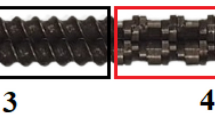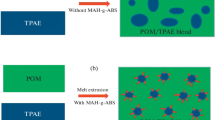Abstract
Blends polyamide 6 (PA6) and acrylonitrile-butadiene-styrene (ABS) were compatibilized with a styrene–(ethylene–butene)–styrene triblock copolymer grafted with maleic anhydride (SEBS-g-MA). In particular, the effects of ABS (0–100 wt%) and compatibilizer (0, 8, and 16 wt%) content were studied. The blends were first prepared by twin-screw extrusion, and different specimens were prepared by injection molding. From the samples produced, the effects of blend composition on morphological, mechanical, rheological, and thermal properties are reported. The structural analysis confirmed that the original blend is immiscible but showed some compatibilization when in the presence of SEBS-g-MA. Incorporation of the compatibilizer and ABS showed negligible effect on the melting behavior of PA6. The compatibilized blends showed higher tensile strength compared with uncompatibilized ones. However, Young’s modulus decreased with increasing compatibilizer content. The mechanical results were confirmed by rheological measurements in terms of interaction between each components in the blend.









Similar content being viewed by others
References
Okonkwo EG, Anabaraonye CN, Daniel-Mkpume CC, Egoigwe SV, Okeke PE, Whyte FG, Okoani AO (2020) Mechanical and thermomechanical properties of clay-Bambara nut shell polyester bio-composite. Int J Adv Manuf Technol 108:2483–2496. https://doi.org/10.1007/s00170-020-05570-w
Gbadeyan OJ, Mohan TP, Kanny K (2020) Processing and characterization of 3D-printed nanoclay/acrylonitrile butadiene styrene (abs) nanocomposite gear. Int J Adv Manuf Technol 109:619–627. https://doi.org/10.1007/s00170-020-05648-5
Fen Yong W, Zhang H (2020) Recent advances in polymer blend membranes for gas separation and pervaporation. Prog Mater Sci 100713:100713. https://doi.org/10.1016/j.pmatsci.2020.100713
Yousef BF, Mourad AHI, Hilal-Alnaqbi A (2013) Modeling of the mechanical behavior of polyethylene/polypropylene blends using artificial neural networks. Int J Adv Manuf Technol 64:601–611. https://doi.org/10.1007/s00170-012-4069-4
Agboola O, Sunday O, Fayomi I et al (2020) Materials today: Proceedings polymers blends for the improvement of nanofiltration membranes in wastewater treatment: a short review. Mater Today Proc. https://doi.org/10.1016/j.matpr.2020.05.387
Kuo CFJ, Wu YS (2006) Optimization of the film coating process for polymer blends by the grey-based Taguchi method. Int J Adv Manuf Technol 27:525–530. https://doi.org/10.1007/s00170-004-2217-1
Balderrama-Armendariz CO, MacDonald E, Roberson DA, Ruiz-Huerta L, Maldonado-Macias A, Valadez-Gutierrez E, Caballero-Ruiz A, Espalin D (2019) Folding behavior of thermoplastic hinges fabricated with polymer extrusion additive manufacturing. Int J Adv Manuf Technol 105:233–245. https://doi.org/10.1007/s00170-019-04196-x
Wei B, Lin Q, Zheng X, Gu X, Zhao L, Li J, Li Y (2019) Reactive splicing compatibilization of immiscible polymer blends: compatibilizer synthesis in the melt state and compatibilizer architecture effects. Polymer (Guildf) 185:121952. https://doi.org/10.1016/j.polymer.2019.121952
Daitx TS, Jacoby CG, Ferreira CI, Schneider PH, Mauler RS (2019) Kaolinite-based Janus nanoparticles as a compatibilizing agent in polymer blends. Appl Clay Sci 182:105291. https://doi.org/10.1016/j.clay.2019.105291
Zuo X, Xue Y, Zhou Y, Yin Y, Li TD, Wang L, Chuang YC, Chang CC, Rafailovich MH, Guo Y (2020) The use of low cost, abundant, homopolymers for engineering degradable polymer blends: compatibilization of poly(lactic acid)/styrenics using poly(methyl methacrylate). Polymer (Guildf) 186:122010. https://doi.org/10.1016/j.polymer.2019.122010
You W, Yu W (2019) Viscoelastic characterization of compatibilized polymer blends. In: Compatibilization of polymer blends: micro and nano scale phase morphologies, interphase characterization, and properties. Elsevier, pp 435–452
Mayer AC, Scully SR, Hardin BE, Rowell MW, McGehee MD (2007) Polymer-based solar cells. Mater. Today 10:28–33
Wang M, Wang H, Li W, Hu X, Sun K, Zang Z (2019) Defect passivation using ultrathin PTAA layers for efficient and stable perovskite solar cells with a high fill factor and eliminated hysteresis. J Mater Chem A 7:26421–26428. https://doi.org/10.1039/c9ta08314f
Hu X, Wang H, Wang M, Zang Z (2020) Interfacial defects passivation using fullerene-polymer mixing layer for planar-structure perovskite solar cells with negligible hysteresis. Sol Energy 206:816–825. https://doi.org/10.1016/j.solener.2020.06.057
Almeida F De, Correia A, Silva ECE, et al (2018) Compatibilization effect of organophilic clays in PA6/PP polymer blend. In: Procedia manufacturing. Elsevier B.V., pp 1154–1161
Zhao D, Yan D, Fu X, Zhang N, Yang G (2020) Effect of ABS types on the morphology and mechanical properties of PA6/ABS blends by in situ reactive extrusion. Mater Lett 274:128013. https://doi.org/10.1016/j.matlet.2020.128013
Zhao D, Yan D, Zhang N, Yang G (2019) Preparation of super-toughened PA6 with submicron-sized ABS by in situ reactive extrusion method. Mater Lett 251:18–22. https://doi.org/10.1016/j.matlet.2019.05.029
Zhang Z, Cao M, Chen P, Yang B, Wu B, Miao J, Xia R, Qian J (2019) Improvement of the thermal/electrical conductivity of PA6/PVDF blends via selective MWCNTs-NH2 distribution at the interface. Mater Des 177:107835. https://doi.org/10.1016/j.matdes.2019.107835
Liu XQ, Bao RY, Liu ZY, Yang W, Xie BH, Yang MB (2013) Effect of nano-silica on the phase inversion behavior of immiscible PA6/ABS blends. Polym Test 32:141–149. https://doi.org/10.1016/j.polymertesting.2012.09.003
Arsad A, Rahmat AR, Hassan A, Iskandar SN (2011) Mechanical and rheological characterization of PA6 and ABS blends-with and without short glass fiber. J Appl Sci 11:2313–2319. https://doi.org/10.3923/jas.2011.2313.2319
Sharma V, Kapoor S, Goyal M, Jindal P (2020) Enhancement of the mechanical properties of graphene based acrylonitrile butadiene styrene (ABS) nanocomposites. Mater Today Proc 28:1744–1747. https://doi.org/10.1016/j.matpr.2020.05.155
Zhou C, Yu W (2003) A rheological model for the interface of immiscible polymer melt in blending process. Can J Chem Eng 81:1067–1074. https://doi.org/10.1002/cjce.5450810519
Shen J, Piunova VA, Nutt S, Hogen-Esch TE (2013) Blends of polystyrene and poly(n-butyl methacrylate) mediated by perfluorocarbon end groups. Polymer (Guildf) 54:5790–5800. https://doi.org/10.1016/j.polymer.2013.08.059
Qaiss A, Bouhfid R, Essabir H (2015) Characterization and use of coir, almond, apricot, argan, shells, and wood as reinforcement in the polymeric matrix in order to valorize these products
Nekhlaoui S, Essabir H, Kunal D, Sonakshi M, Bensalah MO, Bouhfid R, Qaiss A (2015) Comparative study for the talc and two kinds of moroccan clay as reinforcements in polypropylene-SEBS- g-MA matrix. Polym Compos 36:675–684. https://doi.org/10.1002/pc.22986
Essabir H, Rodrigue D, Bouhfid R, Qaiss AEK (2016) Effect of nylon 6 (PA6) addition on the properties of glass fiber reinforced acrylonitrile-butadiene-styrene. Polym Compos. 39:14–21. https://doi.org/10.1002/pc.23895
Boujmal R, Essabir H, Nekhlaoui S, et al (2014) Composite from polypropylene and henna fiber: structural, mechanical and thermal properties. J Biobased Mater Bioenergy 8. https://doi.org/10.1166/jbmb.2014.1420
Essabir H, Raji M, Laaziz SA, Rodrique D, Bouhfid R, Qaiss A (2018) Thermo-mechanical performances of polypropylene biocomposites based on untreated, treated and compatibilized spent coffee grounds. Compos Part B Eng 149:1–11. https://doi.org/10.1016/j.compositesb.2018.05.020
Bensalah H, Gueraoui K, Essabir H, Rodrigue D, Bouhfid R, Qaiss A (2017) Mechanical, thermal, and rheological properties of polypropylene hybrid composites based clay and graphite. J Compos Mater 51:3563–3576. https://doi.org/10.1177/0021998317690597
Malha M, Nekhlaoui S, Essabir H, Benmoussa K, Bensalah MO, Arrakhiz FE, Bouhfid R, Qaiss A (2013) Mechanical and thermal properties of compatibilized polypropylene reinforced by woven doum. J Appl Polym Sci 130:4347–4356. https://doi.org/10.1002/app.39619
Essabir H, Hilali E, El Minor H et al (2015) Mechanical and thermal properties of polymer composite based on natural fibers: Moroccan Luffa sponge/high density polyethylene. J Biobased Mater Bioenergy 9:9–357. https://doi.org/10.1166/jbmb.2015.1524
Kakou CA, Essabir H, Bensalah M-O, Bouhfid R, Rodrigue D, Qaiss A (2015) Hybrid composites based on polyethylene and coir/oil palm fibers. J Reinf Plast Compos 34:1684–1697. https://doi.org/10.1177/0731684415596235
Pelin CE, Pelin G, Ştefan A et al (2016) Mechanical properties of polyamide/carbon-fiber-fabric composites. Mater Technol 50:723–728. https://doi.org/10.17222/mit.2015.171
Kusmono, Mohd Ishak ZA, Chow WS et al (2008) Influence of SEBS-g-MA on morphology, mechanical, and thermal properties of PA6/PP/organoclay nanocomposites. Eur Polym J 44:1023–1039. https://doi.org/10.1016/j.eurpolymj.2008.01.019
Bai X, Isaac DH, Smith K (2007) Reprocessing acrylonitrile–butadiene–styrene plastics: structure–property relationships. Polym Eng Sci 47:120–130. https://doi.org/10.1002/pen.20681
Bokria JG, Schlick S (2002) Spatial effects in the photodegradation of poly(acrylonitrile-butadiene-styrene): a study by ATR-FTIR. Polymer (Guildf) 43:3239–3246. https://doi.org/10.1016/S0032-3861(02)00152-0
Chen G, Shen D, Feng M, Yang M (2004) An attenuated total reflection FT-IR spectroscopic study of polyamide 6/clay nanocomposite fibers. Macromol Rapid Commun 25:1121–1124. https://doi.org/10.1002/marc.200400079
Infrared and Raman characteristic group frequencies: tables and charts, 3rd Edition. Wiley. https://www.wiley.com/en-us/Infrared+and+Raman+Characteristic+Group+Frequencies%3A+Tables+and+Charts%2C+3rd+Edition-p-9780470093078. Accessed 21 Jun 2020
Raji M, Essabir H, Rodrigue D, Bouhfid R, Qaiss A (2017) Influence of graphene oxide and graphene nanosheet on the properties of polyvinylidene fluoride nanocomposites. Polym Compos 39:2932–2941. https://doi.org/10.1002/pc.24292
Essabir H, Raji M, Essassi EM, Rodrigue D, Bouhfid R, Qaiss A (2017) Morphological, thermal, mechanical, electrical and magnetic properties of ABS/PA6/SBR blends with Fe3O4 nano-particles. J Mater Sci Mater Electron 28:17120–17130. https://doi.org/10.1007/s10854-017-7639-2
Essabir H, Bensalah MO, Rodrigue D, Bouhfid R, Qaiss A (2016) Biocomposites based on Argan nut shell and a polymer matrix: effect of filler content and coupling agent. Carbohydr Polym 143:70–83. https://doi.org/10.1016/j.carbpol.2016.02.002
Essabir H, Nekhlaoui S, Bensalah MO, et al (2017) Phosphogypsum waste used as reinforcing fillers in polypropylene based composites: structural, mechanical and thermal properties. J Polym Environ 25. https://doi.org/10.1007/s10924-016-0853-9
Tiouitchi G, Raji M, Mounkachi O, et al (2019) Black phosphorus-based polyvinylidene fluoride nanocomposites: synthesis, processing and characterization. Compos Part B Eng 175. https://doi.org/10.1016/j.compositesb.2019.107165
Mojarrad A, Jahani Y, Barikani M (2012) Influence of nanoclay on the rheological properties of polyamide 6/acrylonitrile butadiene styrene nanocomposites. J Appl Polym Sci 125:E571–E582. https://doi.org/10.1002/app.34092
Essabir H, Elkhaoulani A, Benmoussa K, Bouhfid R, Arrakhiz FZ, Qaiss A (2013) Dynamic mechanical thermal behavior analysis of doum fibers reinforced polypropylene composites. Mater Des 51:51–788. https://doi.org/10.1016/j.matdes.2013.04.092
Laaziz SA, Raji M, Hilali E, Essabir H, Rodrigue D, Bouhfid R, Qaiss A (2017) Bio-composites based on polylactic acid and argan nut shell: production and properties. Int J Biol Macromol 104:104–142. https://doi.org/10.1016/j.ijbiomac.2017.05.184
Araújo EM, Hage E, Carvalho AJF (2004) Thermal properties of nylon6/ABS polymer blends: compatibilizer effect. J Mater Sci 39:1173–1178. https://doi.org/10.1023/B:JMSC.0000013872.86575.36
Fornes TD, Yoon PJ, Keskkula H, Paul DR (2001) Nylon 6 nanocomposites: the effect of matrix molecular weight. Polymer (Guildf) 42:09929–09940. https://doi.org/10.1016/s0032-3861(01)00552-3
Raji M, Essassi E, Essabir H, et al (2019) Properties of nano-composites based on different clays and polyamide 6/acrylonitrile butadiene styrene blends. In: Bio-based polymers and nanocomposites: preparation, processing, properties & performance. Springer International Publishing, pp 107–128
Bose S, Bhattacharyya AR, Kodgire PV, Misra A, Pötschke P (2007) Rheology, morphology, and crystallization behavior of melt-mixed blends of polyamide6 and acrylonitrile-butadiene-styrene: influence of reactive compatibilizer premixed with multiwall carbon nanotubes. J Appl Polym Sci 106:3394–3408. https://doi.org/10.1002/app.27018
Author information
Authors and Affiliations
Corresponding authors
Additional information
Publisher’s note
Springer Nature remains neutral with regard to jurisdictional claims in published maps and institutional affiliations.
Rights and permissions
About this article
Cite this article
Essabir, H., El Mechtali, F.Z., Nekhlaoui, S. et al. Compatibilization of PA6/ABS blend by SEBS-g-MA: morphological, mechanical, thermal, and rheological properties. Int J Adv Manuf Technol 110, 1095–1111 (2020). https://doi.org/10.1007/s00170-020-05888-5
Received:
Accepted:
Published:
Issue Date:
DOI: https://doi.org/10.1007/s00170-020-05888-5




